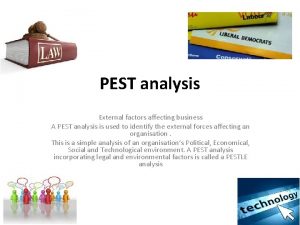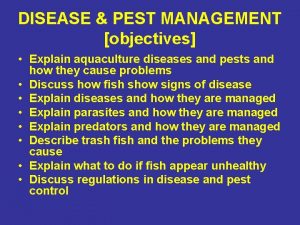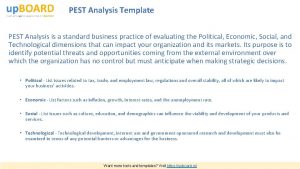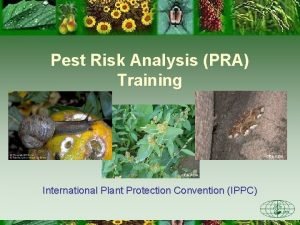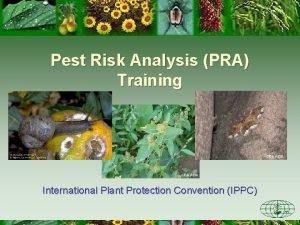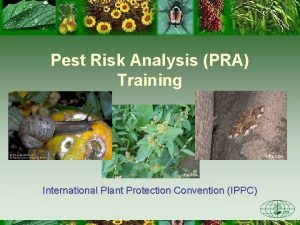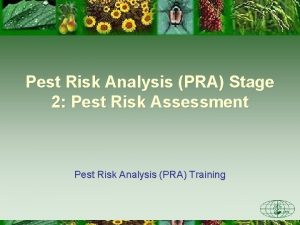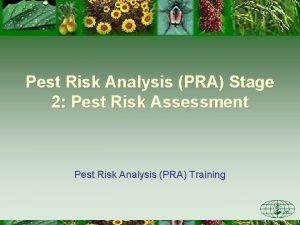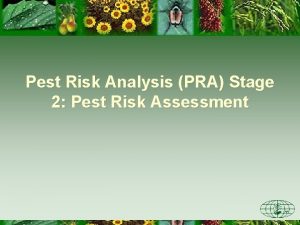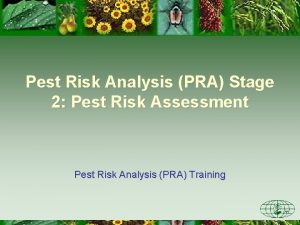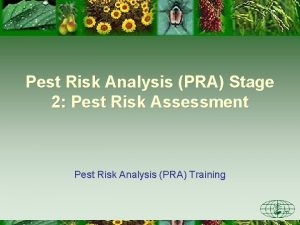Pest Risk Analysis PRA Training CFIAACIA International Plant











- Slides: 11

Pest Risk Analysis (PRA) Training CFIA-ACIA International Plant Protection Convention (IPPC) 1

Risk Communication Pest Risk Analysis (PRA) Training

Risk Communication • Two-way communication – Get information – Give information • Continuous throughout PRA process – Different purposes & audiences at different points in process • Why? Who? What? When? How?

Why? • IPPC principle of transparency • Ensures completeness & validity of information used in PRA • Facilitates mutual understanding & compliance – Government and stakeholders will often reach the same conclusions – Experts better able to contribute • Facilitates international harmonization • Ensures a better conclusion -- ultimately a better policy

Why? • Different parties bring different information, opinions, expertise and viewpoints; – Producers & industry representatives know about the affected industry, environment or commodity – Researchers know about the pest(s), their biology, control, identification, or survey methods etc. – Economists understand the bigger economic implications – Many others … • Impossible for NPPO to fully understand all facets and impacts of policy

Who? - National and sub- Scientific community national governments - Environmental groups - Other NPPOs or RPPOs - Aboriginal groups - National, provincial and Private citizens, local industry landowners associations - Growers, sellers, • Take your time to be sure you’ve identified everyone processors

What? When? • Different audiences at different points in process • Initiation – Potentially affected stakeholders – Other NPPOs • Risk assessment – – Pest experts Scientists, academia Economists Modellers – – Pest control specialists Survey or inspection experts Potentially affected stakeholders Other government agencies • Risk management • Each case is a little different • Communicate as issues or questions arise

How? • Interactive – – – Telephone Face-to-Face Meetings In writing • Passive & Active Tools for Presentations communicating each Polls • Passive – Websites – Posters – Handouts have their benefits • Using multiple tools assures the furthest reach

Expert Opinion • Person with special knowledge in a particular subject area • Seek expert opinion to: – Contribute to a PRA or part thereof – Validate a PRA or part thereof • Experts should: – Come from a variety of places – Understand the purpose of their contribution – Understand PRA

Risk Communication • • • Continuous Two-way Seek out experts Explain PRA Give parties opportunity to contribute • Let them know their contribution is valued • Integrated input into PRA, where possible

Challenges • NPPO must try to balance multiple points of view and deal with uncertainty • Which values are “worth” more? – Economic – Environmental • How can we be certain of doing the right thing? • How can we be sure we talked to the right person or people? • How can we be sure they understand?
 Liquidity measures
Liquidity measures Tesco technological factors
Tesco technological factors Aquaculture pest analysis
Aquaculture pest analysis Pest analysis template
Pest analysis template C-pest analysis for an event
C-pest analysis for an event Plant introduction in plant breeding
Plant introduction in plant breeding Plant introduction in plant breeding
Plant introduction in plant breeding Plant introduction in plant breeding
Plant introduction in plant breeding Tronsmo plant pathology and plant diseases download
Tronsmo plant pathology and plant diseases download Tronsmo plant pathology and plant diseases download
Tronsmo plant pathology and plant diseases download Tronsmo plant pathology and plant diseases download
Tronsmo plant pathology and plant diseases download What is risk projection in software engineering
What is risk projection in software engineering

